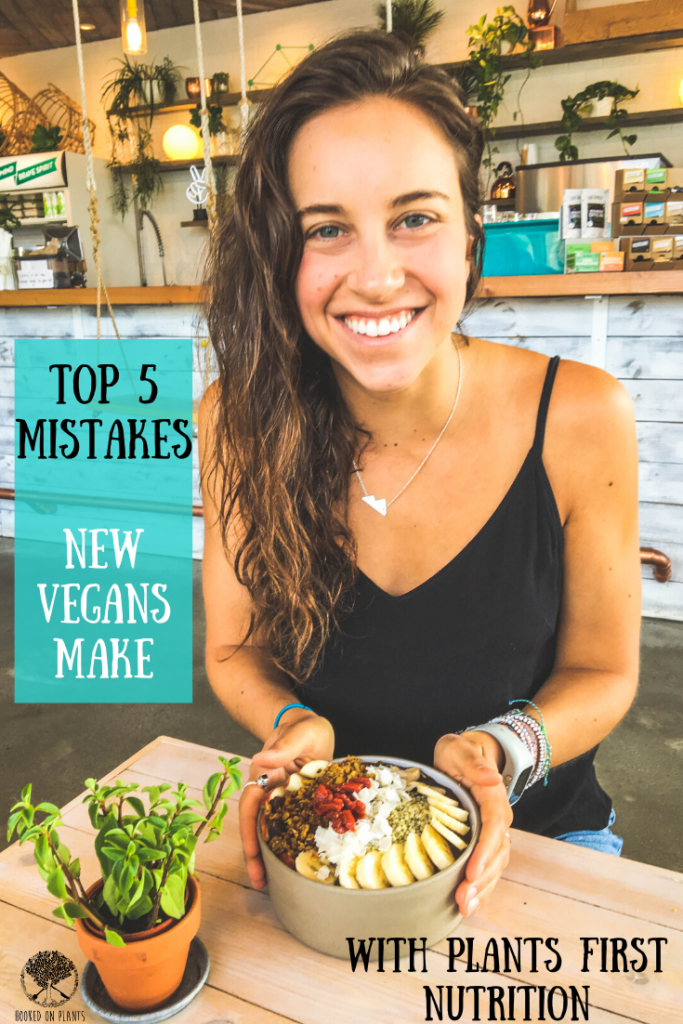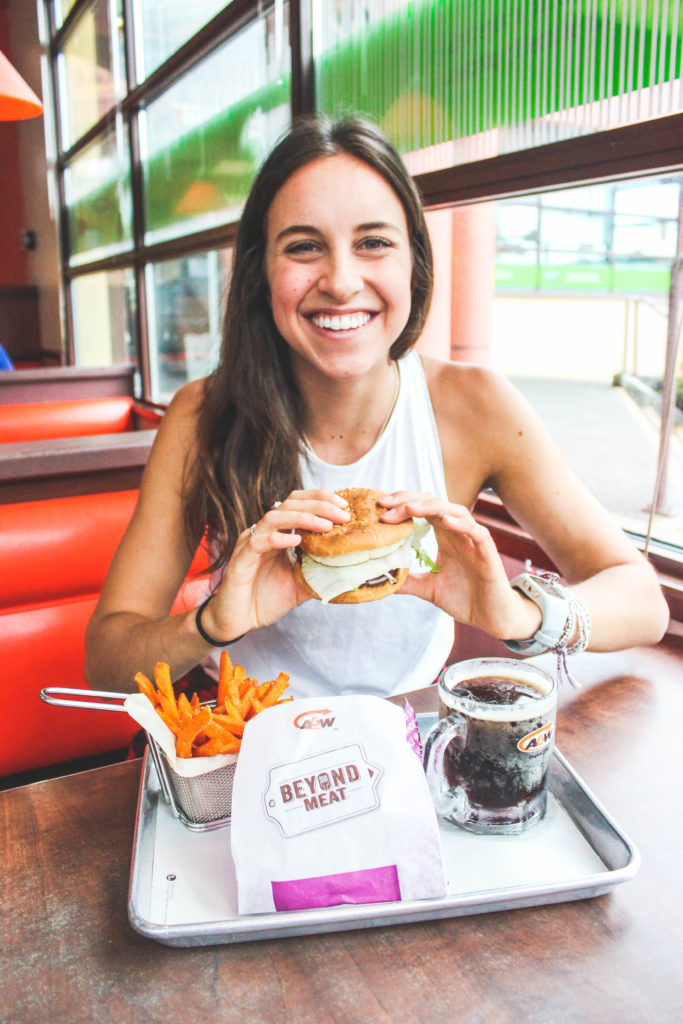Roslyn Kent AKA Plants First Nutrition: love her.
She loves plants, she’s a holistic nutritionist, she loves to adventure in the mountains, and she’s passionate about the environment, animals, and helping people achieve their most balanced and healthy self in a super informative, fun, approachable way. I have loved connecting with her over the last few years, and am constantly inspired by her deep knowledge and unique way of educating her community.
Plus, she’s now a part of the inaugural Wyld Trybe of Stay Wyld Organics, sharing the benefits of our newly launched medicinal mushrooms! (MORE coming on that in the next post)
She graces us with her knowledge and recipe development skills today.
Enjoy the read and the eats, and don’t forget to give her a follow, share this, tag her (@plantsfirstnutrition) and I.
From the amount of value she puts out to the world, she deserves all the love back to her.

1) Not eating enough calories:
A whole food plant based diet is naturally lower in calories, but typically higher in antioxidants, fiber, vitamins and minerals. This usually means that you can eat much more on a plant based diet compared to a standard American diet. Picture a stomach filled to the brim with vegetables. Now picture instead a stomach with 3 oz of steak and 1 tbsp of oil. The calories may be similar, but the volume is much different. This is a prime example of why you might feel more hungry on a plant based diet, and why it’s so important to not only increase the volume of food you eat, but the variety of food too. While you’ll want most of your daily food intake to come from carbohydrates, including leafy greens, fruit, whole grains, and starchy vegetables, it’s important to add in whole food forms of fat too, including nuts, seeds, nut butters, avocados, etc. as well as plant based protein (legumes, seeds, etc.) These will work to keep you feeling satiated. But the bottom line here is, if you under eat on a plant based diet, as with any diet, you’ll feel fatigued, lethargic, drained, and generally like sh*t. And not surprisingly, I see this a lot among new vegans. The common trend is to replace animal foods with plants, but the quantity on a plate often doesn’t increase. I don’t recommend counting calories on any diet, and especially not on a vegan diet, simply because it’s hard to overdo it, and you should be eating to feel full. If you choose to work with me, we can work together to up your food intake in a way that doesn’t feel like you’re always eating. Or maybe, you do like to eat, and that’s okay with you. We can work out something that fits your lifestyle, but the key here is to ensure sufficiency without filling your diet with processed foods.
2) Cutting out major food groups (without an allergy or sensitivity):
It’s one thing to be vegan. It’s another thing to be vegan, gluten free, lectin free, night-shade free, and nut free. I am not referring to food allergies, but instead the decision to avoid certain foods based on fear mongering and fat diet trends. All whole food plants are healthy, and all whole food plants can be healthfully incorporated into an everyday diet. No, lectins aren’t bad for you. No, a little oil every once in a while won’t kill you. No, gluten isn’t the enemy unless you’re legitimately celiac or sensitive, and no, night shades aren’t an issue unless you have severe inflammation in the body. The emphasis here is on whole food plant based, including all plants (unless sensitivities or allergies are at play) but leaving room for indulgences, vegan meat/dairy alternatives, and treats the other 20% of the time to keep life interesting and your soul happy. A vegan diet is not restrictive, but if you make it so voluntarily, you may run into issues and miss out on a variety of nutrients your body needs to thrive!
3) Eating too much raw food
Despite what you might have been told, vegans don’t just live off of salads. In fact, some vegans might not even be able to properly digest salad, let alone rough raw vegetables such as kale, celery, and carrots. You are what you eat, but even more so, you are what you digest, and if you can’t digest raw food, then why try to eat an abundance of it? Would it not make more sense to eat a variety of whole plant foods that are cooked and easier to digest until you can build up your ability to digest raw foods? Rabbits might eat raw carrots and Gorillas might eat raw leaves, but that doesn’t mean you should eat mostly raw if that’s not something your stomach or your intestines can handle. This will only contribute to indigestion, bloating, gas, and abdominal discomfort in the long run. Work with me to address your initial digestive concerns and we can work you up to a salad eating machine!

4) Not supplementing with the right things
It’s easy to think that a vegan diet is the be all, end all. And while I do in fact believe that it is by far the most healthy, sustainable, and animal friendly ways to live and eat, I do understand that it falls short of a few key nutrients. This isn’t because the plant kingdom is lacking nutrients, but instead, because our toxic world changes the way we digest food and the ability to get certain nutrients from our food. For example, you’ve probably heard that a vegan diet is lacking B12. This is true in a way, but only because B12 is created by bacteria, and the conditions in which we grow food are now so sterile, there’s no opportunity for B12 to proliferate in vegetables. Our guts make a small amount, but not enough to be sufficient for a lifetime. Animal eaters can get B12 from eating animal flesh, but again, the amount has decreased due to antibiotic use and sterilization of the gut—even cows are given B12 shots today to up the concentration of B12 that ends up in the beef on your plate.
I often hear of first time vegans feeling fantastic after one month of being vegan, but after 4-6 months, they feel fatigued and exhausted, all the time. This is usually due to one of a few things: inability to digest certain foods, food sensitivities, or not supplementing with the right nutrients. Book an appointment with me to determine exactly what nutrients you might need as a new vegan, as this can be a very individual thing!

5) Eating the same style of meals they did before, but vegan.
You used to eat chicken, vegetables and white rice for dinner as an omnivore? Good luck trying to eat only plain vegetables and white rice instead each night. White bagels and cream cheese every morning for breakfast? Bagels and vegan cream cheese must be a good substitute, no? Or what about just salad with veg, without the chicken. Is that okay? The answer is a bit more complicated than a straight yes or no. The problem with adopting a plant based diet and not diversifying your diet is that you’ll feel, well, blah. The key to feeling energized and vibrant on a vegan diet is to increase the variety of foods you eat (in addition to the volume—see above). We’ve come a long way since meat and potatoes, so to take away meat and simply fail to replace that meat with a variety of plants might take you down the wrong path. The best way to diversify your diet (while still keeping things relatively simple) is to research vegan recipes. Try one new recipe a week, and before you know it you’ll have a laundry list of go-to recipes that you can make throughout the month without any effort. Try to buy at least 15 different vegetables every week at your local grocery store and google recipes that incorporate combinations of those plants. You might be surprised to find that an unexpected meal turns out to be your favourite!

ROSLYN’S SPICY CAULIFLOWER & AVOCADO RANCH PIZZA
- 2 cups all purpose flour (can swap for GF all purpose)
- 1 package of instant yeast
- ½ tsp salt
- 1 tsp coconut or cane sugar
- ½ tsp dried basil (optional)
- ½ tsp dried oregano (optional)
- 3 tbs olive olive
- 1 cup hot water from the tap
- ⅓ cup vegan mayo
- 1 small ripe avocado
- ½ tsp onion powder
- ¼ tsp salt
- ¼ tsp pepper
- ½ tsp dried dill (can sub for 1-2 tbsp fresh)
- ½ tsp dried parsley (can sub for 1-2 tbsp fresh)
- 1 tsp apple cider vinegar
- 1 tsp maple syrup
- 1 head of cauliflower chopped into small florets
- ⅓ cup franks hot sauce
- ½ cup homemade or store bought pizza sauce
- 3 stalks of green onion, sliced diagonally into thin pieces
- Preheat the oven to 425 degrees F and place your pizza stone in the oven to heat up.
- To make the dough, mix the flour, yeast, salt, sugar, and spices in a large mixing bowl. Add the oil and water and stir with a wooden spoon to combine. When the dough starts to form, use your hands to combine until all the flour is absorbed. Set the bowl aside and cover with a tea towel.
- Add the cauliflower florets to a medium sized bowl and add Frank’s hot sauce. Toss to combine. Layer a cookie sheet with parchment paper or a silicon baking mat and add the cauliflower plus extra sauce, spacing it out. Bake at 425 F for 15-18 minutes or until almost cooked (the cauliflower will spend 10 more minutes in the oven later on!). Remove the cauliflower from the oven when finished and bring the heat up to 450 F.
- Combine all the avocado ranch sauce ingredients (mayo to syrup) in a high speed blender or food processor and blend until smooth.
- To assemble the pizza, place your dough ball on a clean, lightly floured counter space. Use your hands to stretch the dough out from the center. Pick it up and place your fists in the middle, rotating the dough in a circular motion slowly as you stretch it out until it reaches the desired width (approximately 12″).
- Carefully remove the pizza stone from the oven* and place onto hot plates on the counter. Lightly fold your dough in half and move it onto the stone, unfolding it once it’s positioned to your liking.
- Add the tomato sauce to the base of the pizza and spread around to the edges.
- Add the cauliflower pieces and ¾ of the green onion, spacing them out evenly.
- Place the pizza in the oven at 450 F and cook for 11-14 minutes or until the edges are browned and the underside is cooked through.
- Carefully remove the pizza from the oven and place it back on to the hot plates. Top with generous dollops of the vegan avocado ranch and sprinkle with remaining green onion.
- Slice into 8 even pieces and enjoy!
Making this? Tag @plantsfirstnutrition and @hookedonplants
Need a guide towards a plant-based lifestyle? Try the 80/20 Plants Program
Check out my e-book (your new vegan handbook) AKA …all you need for a #PlantsForAWeek mini challenge.

For more inspiration and info on eating plant-based, sign up to my emails for bi-weekly inspiration, recipes, plus a free PDF on How to Get Hooked On Plants!





